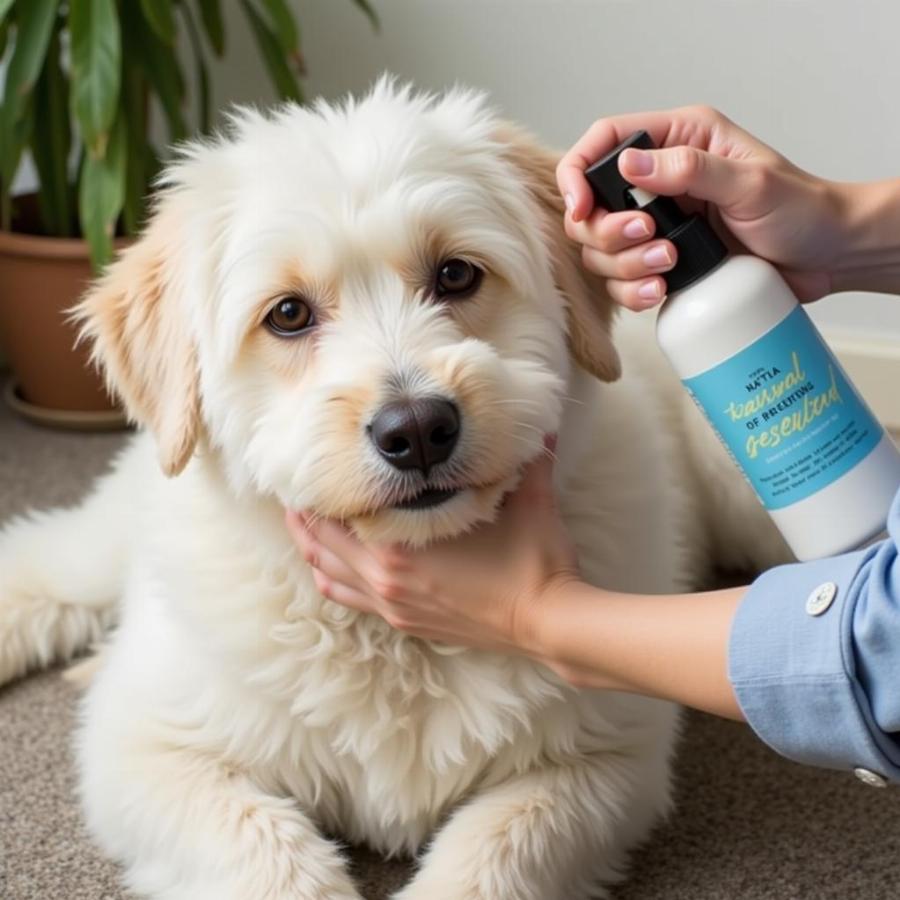Fly spray and dogs – two things that don’t always mix well. As a dog owner, you want to protect your furry friend from pesky flies, but also ensure their safety. This comprehensive guide will delve into the world of fly sprays and dogs, offering valuable insights into choosing the right product, applying it safely, and understanding potential risks. We’ll cover everything from natural repellents to chemical solutions, helping you make informed decisions to keep your beloved companion happy, healthy, and fly-free.
Understanding the Need for Fly Spray for Dogs
Flies can be more than just a nuisance for dogs. They can transmit diseases, cause irritation, and even lead to infections. Especially for dogs spending significant time outdoors, fly control becomes crucial. But how do you choose the right fly spray? What ingredients should you look for? And what safety precautions should you take? Let’s explore these questions.
Choosing the Right Fly Spray: Natural vs. Chemical
When selecting a fly spray for your dog, you’ll encounter two main categories: natural and chemical. Natural repellents often utilize essential oils like citronella, lemongrass, and eucalyptus. These can be effective for short-term protection and are generally considered safer for sensitive dogs.  Xịt chống côn trùng thiên nhiên cho chó However, they may need more frequent reapplication. Chemical fly sprays, on the other hand, contain synthetic insecticides like permethrin or pyrethrins. These tend to offer longer-lasting protection but require careful application and adherence to instructions.
Xịt chống côn trùng thiên nhiên cho chó However, they may need more frequent reapplication. Chemical fly sprays, on the other hand, contain synthetic insecticides like permethrin or pyrethrins. These tend to offer longer-lasting protection but require careful application and adherence to instructions.
Is Permethrin Safe for Dogs?
Permethrin is a common insecticide found in many fly sprays, but it’s crucial to understand that permethrin formulated for dogs is different from permethrin formulated for other animals or for use in the home. Never use a fly spray containing permethrin intended for anything other than dogs. Even dog-formulated permethrin can be toxic if ingested, so always apply it as directed and prevent your dog from licking the treated area. natural bug repellent for dogs offer a safer alternative if you’re concerned about chemical exposure.
Applying Fly Spray Safely to Your Dog
Before applying any fly spray, always test it on a small area of your dog’s skin to check for any allergic reactions. Avoid spraying near the eyes, nose, and mouth. Apply the spray in a well-ventilated area and follow the manufacturer’s instructions carefully. If using a spray containing permethrin, ensure your dog is dry before application and avoid bathing them for a few days afterward. Consider using a cargo net for dogs if you’re transporting your dog in a vehicle after applying the spray, to prevent them from licking the treated area.
What if My Dog Licks Fly Spray?
If your dog ingests fly spray, contact your veterinarian immediately. Symptoms of fly spray toxicity can range from mild skin irritation to more severe neurological issues. my dog ate a fly might not be as serious, but ingesting fly spray can be dangerous. Prompt veterinary care is essential.
Alternative Fly Control Methods for Dogs
Beyond fly sprays, several other methods can help protect your dog from flies. These include fly traps, fly predators (like certain species of wasps), and physical barriers like fly screens. Maintaining a clean environment, especially around food and water bowls, can also help deter flies. A dog fly repellent can also offer added protection.
Conclusion: Keeping Your Dog Fly-Free and Safe
Protecting your dog from flies is essential for their health and well-being. By carefully choosing and applying fly spray, and considering alternative fly control methods, you can keep your furry friend happy, healthy, and fly-free all season long. Remember to always consult your veterinarian if you have any concerns about fly control or your dog’s health.
FAQ: Frequently Asked Questions about Fly Spray and Dogs
- Can I use human fly spray on my dog? No, never use human fly spray on a dog. Human fly sprays contain different ingredients and concentrations that can be toxic to dogs.
- How often should I apply fly spray to my dog? Follow the manufacturer’s instructions. Over-application can be harmful.
- What are the signs of fly spray toxicity in dogs? Symptoms can include excessive drooling, vomiting, tremors, seizures, and difficulty breathing.
- Are natural fly sprays as effective as chemical ones? Natural fly sprays can be effective for short-term protection, but they may need more frequent reapplication.
- What should I do if my dog gets fly spray in its eyes? Flush the eyes immediately with plenty of clean water and contact your veterinarian.
- Can I make my own fly spray for my dog? While some DIY recipes exist, it’s crucial to consult with your veterinarian before using homemade fly sprays to ensure they are safe and effective.
- Are there any breeds of dogs more susceptible to fly bites? Dogs with thin coats or exposed skin, such as Whippets or Chinese Crested dogs, may be more susceptible to fly bites.
More questions?
Do you have more questions about caring for your dog? Check out our article on best vacations with dogs.
Beaut Dogs: Your Ultimate Resource for Canine Care
Beaut Dogs is your go-to resource for everything dog-related. We provide comprehensive information on dog breeds, care, health, and much more. When you need expert advice, contact us at Email: [email protected] for detailed and accurate answers from Beaut Dogs.